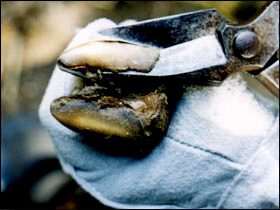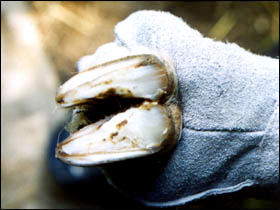Goat Health is a massive and important topic, and it cannot logically be treated separately from all aspects of goat management and welfare.
GOAT DISEASES LEAFLET – click to open
Q & As
What follows below are some “answers” to a selection of basic “questions”, and also advice about how to learn more.
How do I keep my goats healthy?

Close observation of your herd is essential to help you to learn what is “normal”, and since some illnesses have a gradual onset being able to spot the slightest change in an individual goat will enable you to act promptly and prevent any risk there may be to herd health as a whole.
Observe and ask yourself daily:
Is the goat alert and inquisitive, with bright eyes and a clean nose?
Is the appetite normal?
Is the goat drinking water?
Are the droppings, firm and pelleted, is the urine a normal colour?
Has the milk yield changed suddenly?
Are there any changes in the udder, in milk-texture, taste, color or smell?
Is the coat silky and shiny and the skin smooth?
Examine your goats, using your hands, regularly in good light, are there any signs of swelling or injury?
Does the goat stand comfortably on all four feet and walk with equal weight on each foot?
Record daily any observed variations from normal. By law you must keep a record of all injections and medications given to your goats, these can be recorded on different pages in the same book or on a BGS Medicine Record Sheet. Check with your vet regarding withdrawal times of milk and/or meat for that medication. Enter in your records when the milk/meat withdrawal period ends.
A GUIDE TO THE “NORMAL” GOAT
| Body temperature (rectal): | 39 – 39.50 C (102.5 – 103 F) |
| Heart rate: | 70 – 95 beats per minute |
| Respiration rate: | 10 – 30 per minute |
| Rumen movement: | 1 -1.5 per minute |
Comparison with other goats in the herd is sound practice (since a hot day, for example, may alter the respiration rate of a number of goats in the herd).
A Clinical thermometer and a watch with a seconds hand are required.
Temperature is taken by gentle insertion of the clinical thermometer in the goat’s anus for a minute, with the goat well secured.
Heart rate is taken by placing each hand either side of the goat’s chest low down behind, and close to, its elbows.
Respiration rate is taken by observation of movement of the goat’s chest and flanks.
Rumen movement is checked by gently pressing a fist into the goat’s left hand side midway between the ribs and the goat’s thigh.
Practice the technique of doing all the above. Reporting these four key observations can help your vet help your goats.
How can I keep my goats feet healthy
Keep the goat’s feet dry for most of the time and keep the goat’s feet moving on firm, but not abrasive, surfaces. It is essential to keep the goat’s feet trimmed on a very regular basis to remove excess growth.
Foot care is a task that one can readily learn from an experienced shepherd or goatkeeper. Most Societies will be happy to help. The technique may differ but the end result must be the same and cause minimum discomfort to you and your goat.
To carry out foot trimming procedures you will require:
A pair of hoof trimming shears and a knife with a short blade (7.5 cm. is sufficient). Each of the tools should be kept very sharp.
A pair of gloves to protect your hands when trimming the feet (from accidental cuts).
An antibiotic purple spray, obtained from your vet, to spray the hoof should you cause accidental bleeding of the foot.
You need to tie up the goat with a collar or halter tied short, with the goat standing against a wall or fence, so that it can be moved round to attend to the feet on each side of the goat in turn. The goat will lean against the wall when having its feet trimmed on the side away from the wall, and it cannot circle away from you.
Start by trimming a front foot, lifting it close to the goat’s side and with as minimum a lift as possible.
Clean off any excess dirt and other material from the base of the hoof with the pointed end of the trimming shears. (see photograph above)
Remove any horn, which may be growing over the foot with the trimming shears. Cut the horn level with the sole all the way round.
Level the heels with the sharp knife, lowering them if necessary, but removing a little at a time.
Carefully pare the sole using the sharp knife to match the new heel level.Remove a little at a time and stop if the sole begins to become pink. Work from the heel towards the toe.
The foot should then look as in the photograph below.
In badly overgrown feet the sole may have degenerated and become crumbly. Scrape off such tissue and spray the foot with the antibiotic spray.
After trimming a front foot move to the back foot on the same side, facing with your head away from the goat’s head, bend over and lift the goat’s foot, again not too high. Then proceed as the front foot. Turn the goat around and repeat the process.
Are goats born without horns?
Yes, but in most goats the horn starts to grow in a few days, starting with a horn bud (which may be felt in newly born kids). Relatively few goats in the UK are naturally hornless.
Disbudding is highly recommended and can, in the UK, only be carried out by a veterinary surgeon and the “patient” must be anaesthetized. A hot disbudding iron is briefly applied to the horn bud. This should be done between 2 and 7 days of age. In some breeds, Angoras and Boers for example, the goats are often not disbudded: dairy breeds are disbudded.


